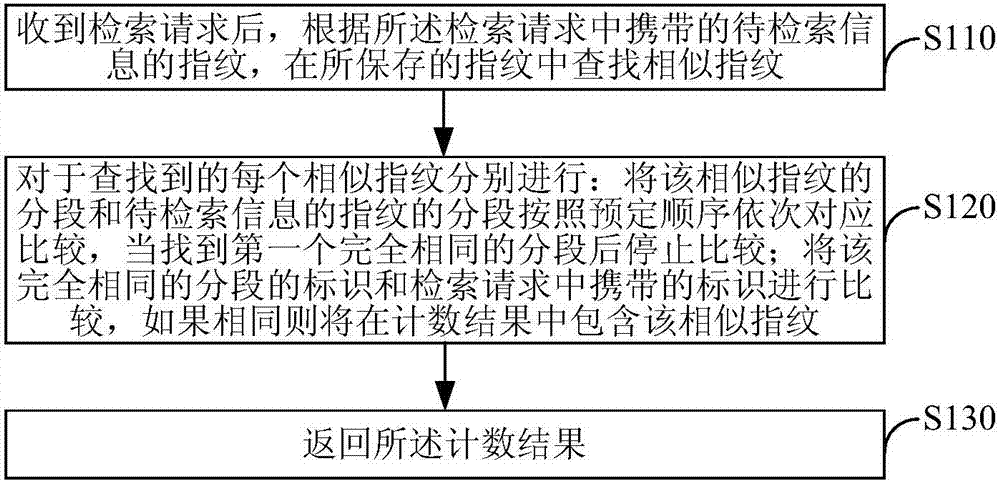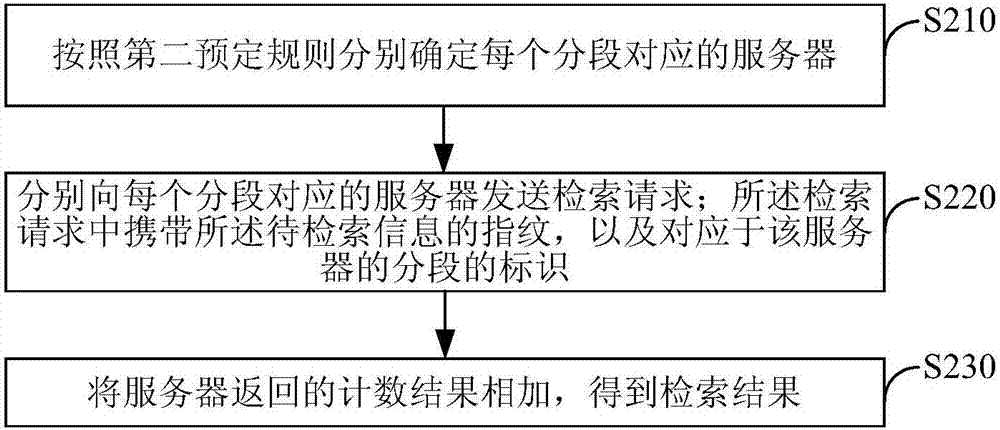Distributed retrieval method and device
A distributed and information retrieval technology, applied in the field of information retrieval, can solve problems such as counting instability, achieve comprehensive retrieval results, speed up processing, and reduce network traffic
- Summary
- Abstract
- Description
- Claims
- Application Information
AI Technical Summary
Problems solved by technology
Method used
Image
Examples
Embodiment 1
[0072] Embodiment 1. A distributed retrieval method, applied to a server, such as figure 1 As shown, steps S110-S130 are included.
[0073] S110. After receiving the retrieval request, search for similar fingerprints in the stored fingerprints according to the fingerprints of the information to be retrieved carried in the retrieval request;
[0074] S120. For each similar fingerprint found, perform the following operations respectively: compare the segment of the similar fingerprint with the segment of the fingerprint of the information to be retrieved according to a predetermined order, and when the first identical segment is found, Stop comparing after the segment; compare the identification of the identical segment with the identification carried in the retrieval request, and if they are the same, include the similar fingerprint in the counting result; wherein, the division of segments and the identification of each segment The identification is determined according to a f...
other Embodiment approach
[0106] In other implementation manners, other ways may also be used to establish and save the corresponding relationship between segments and fingerprints, for example, the segments and their fingerprints may be stored in one-to-one correspondence.
[0107] In an implementation manner of this alternative solution, the server may also classify and save the segments according to the identifiers of the segments, that is, when the segments are saved, the identifiers of the segments are used as indexes; for example, the segment whose identifier is 1 Save together with index "1"; save together the segment identified as "2" with index "2", and so on;
[0108] In this embodiment, the searching for a segment that is exactly the same as the acquired segment among the saved segments may include:
[0109] In the stored segments indexed by the identifier carried in the retrieval request, a segment that is exactly the same as the acquired segment is searched for.
[0110] This embodiment c...
Embodiment 2
[0113] Embodiment 2, a distributed retrieval method, applied to the client, such as figure 2 As shown, steps S210-S230 are included.
[0114] S210. Determine the server corresponding to each segment according to the second predetermined rule;
[0115] S220. Send a retrieval request to the server corresponding to each segment; the retrieval request carries the fingerprint of the information to be retrieved and the identification of the segment corresponding to the server; The identification of the segment is determined according to a first predetermined rule;
[0116] S230. Add up the counting results returned by the server for the retrieval request to obtain a retrieval result.
[0117] In this embodiment, the same type of fingerprint is stored on multiple servers; when the same type of fingerprint is stored on multiple servers, the servers corresponding to different segments of the fingerprint can also be determined according to the first predetermined rule, and the server...
PUM
 Login to View More
Login to View More Abstract
Description
Claims
Application Information
 Login to View More
Login to View More - R&D
- Intellectual Property
- Life Sciences
- Materials
- Tech Scout
- Unparalleled Data Quality
- Higher Quality Content
- 60% Fewer Hallucinations
Browse by: Latest US Patents, China's latest patents, Technical Efficacy Thesaurus, Application Domain, Technology Topic, Popular Technical Reports.
© 2025 PatSnap. All rights reserved.Legal|Privacy policy|Modern Slavery Act Transparency Statement|Sitemap|About US| Contact US: help@patsnap.com



